GSI Diamond Certification Report – Is It Good or Bad?

A diamond grading report (or more commonly known as a certificate) describes the quality and characteristics of a diamond. More importantly, an independent and reliable certification provides you with an assurance that the diamond has been accurately graded without bias from the seller.
2 of the most well-known labs in the world are GIA (Gemological Institute of America) and AGS (American Gem Society). However, with the increasing demand for diamond certification from third-party entities, there is a growing number of gemological labs that offer such services.
The problem here is that each laboratory has its own methodology and standards for grading diamonds. Since there’s no organization or government body that oversees or regulates the grading standards used, it makes it very difficult for consumers to separate the reputable labs from the shady ones.
In today’s article, we will focus on a grading lab called Gemological Science Institution (GSI) and review some of the services they offer. We will also take a look at GSI diamond reports which are often found at large chain stores to see if they are any good.
Let’s jump right in…
Who is Gemological Science International (GSI)?
GSI lab is a recently established and independent laboratory that offers gemstone identification, appraisals and diamond grading services. Their head office of GSI is located in New York City and they have global operations spanning across 7 countries: the United States, India, Dubai, Israel, Belgium, Hong Kong, and Botswana.
Unlike the majority of other geological labs that offer a similar suite of services and remain in obscurity, GSI built their businesses around some of the largest retail chains in the US like Jared and Zales. And that’s how many consumers get to know about the name of GSI lab.
GSI offers a variety of report formats for diamond jewelry such as the Full Diamond Examination (FDX) report, Special Diamond Examination Report (SDX), Intermediate Diamond Examination Report (IDX) and the Modified Diamond Examination Report (MDX).
They also offer customized reports that are tailored to the specific needs of jewelry companies or incorporate the company’s branding such as the example you see below for an engagement ring offered by Fred Meyer Jewelers.
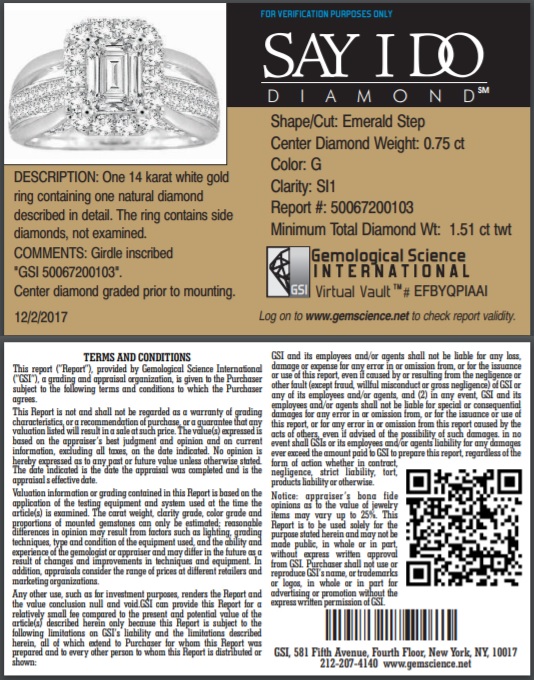
A branded Fred Meyer Jeweler grading report offered by GSI.
A Review of GSI Diamond Grading Reports
The Full Diamond Examination is GSI’s most comprehensive report. On their website, it is stated that the FDX report can include different information such as the 4Cs, fluorescence, polish/symmetry, physical measurements, clarity plots and other details that the client (jeweler selling the product) wants to include.
Below, you can see two such examples of the FDX reports. While looking at them, try to see if you can spot the critical differences between these 2 grading reports.
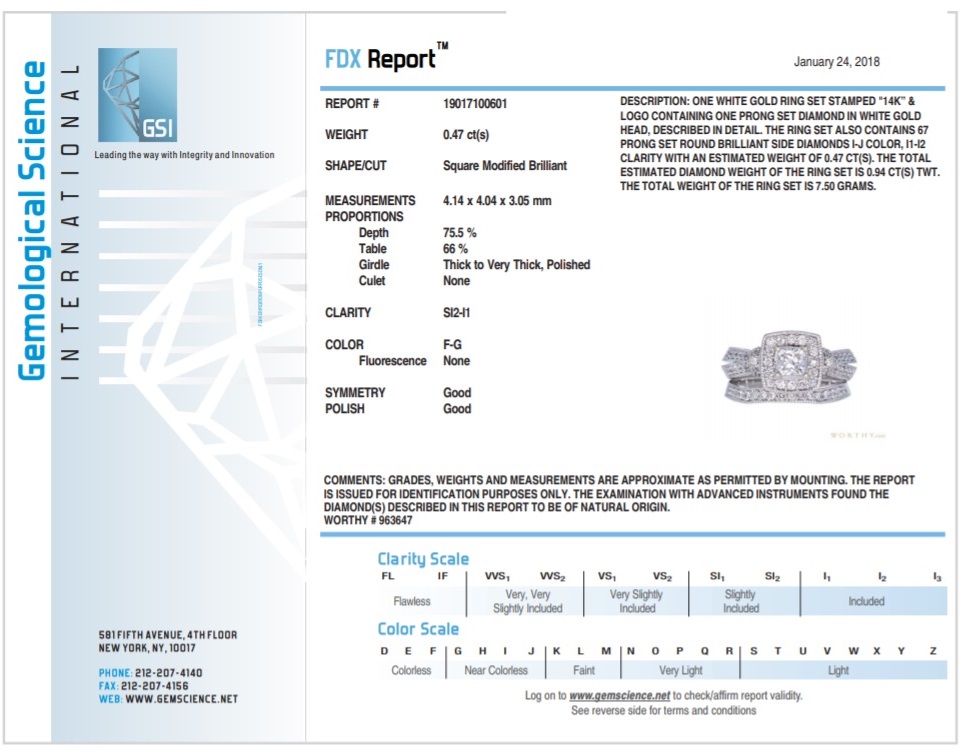
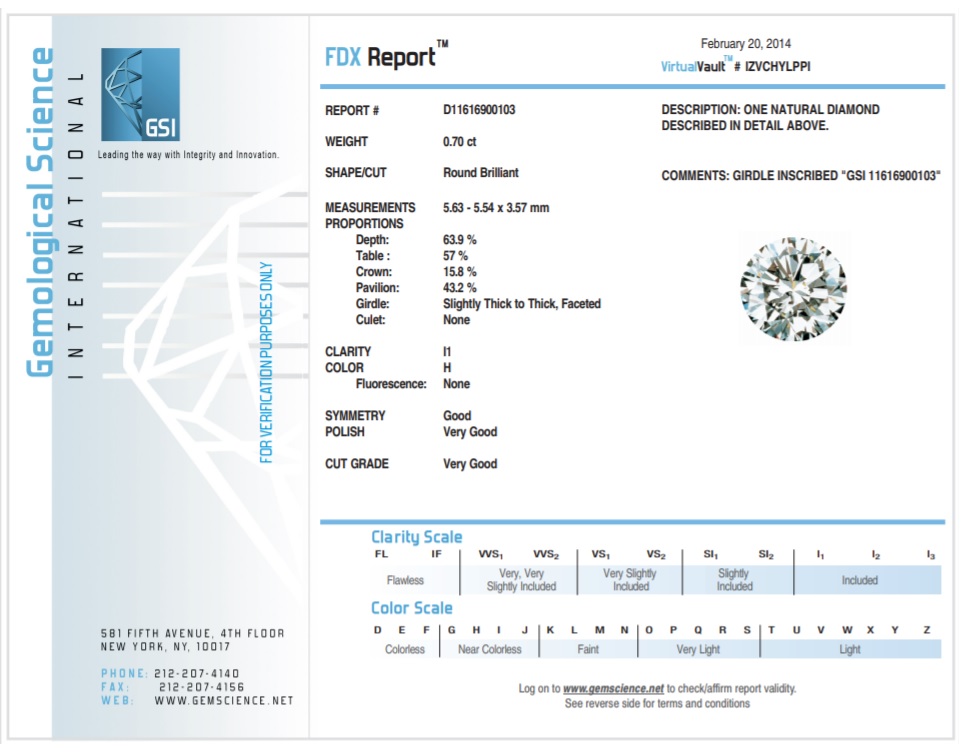
Did you manage to see the differences between these 2 FDX reports? Can you see the contrasting differences in the description areas and the picture of an engagement ring being graded compared to a picture of a round diamond in the other report?
Now, this business practice of allowing clients to selectively choose what goes inside a report perplexes me because it creates inconsistencies. If someone were to compare an FDX report to another FDX report, they would be making a mistake thinking that there were equivalent documents.
But that’s not the most important point. What made me sit up with surprise is that there are also different grading methodologies used depending on what the client wants.
As seen above, one of the FDX reports shows a diamond ring that is graded after the center diamond is mounted and the color/clarity is listed as a range instead of an absolute grade. Yet, in the other FDX report shows a loose round cut diamond that has been graded in its unmounted form.
As a trained grader from GIA, it would be blasphemy if the same type of activities were carried out at a GIA lab. In order for accurate, fair and consistent grading to be carried out, every single diamond graded at GIA must be in the loose form (unmounted from setting).
The point I am making here is that different grading methods shouldn’t be used for the same type of grading report.
The Intermediate Diamond Examination report (IDX) is very similar to an FDX report and the main difference lies in the smaller physical size of the report (6.75″ x 5″ bifold document). While they do exist, I seldom see these being offered by jewelers.
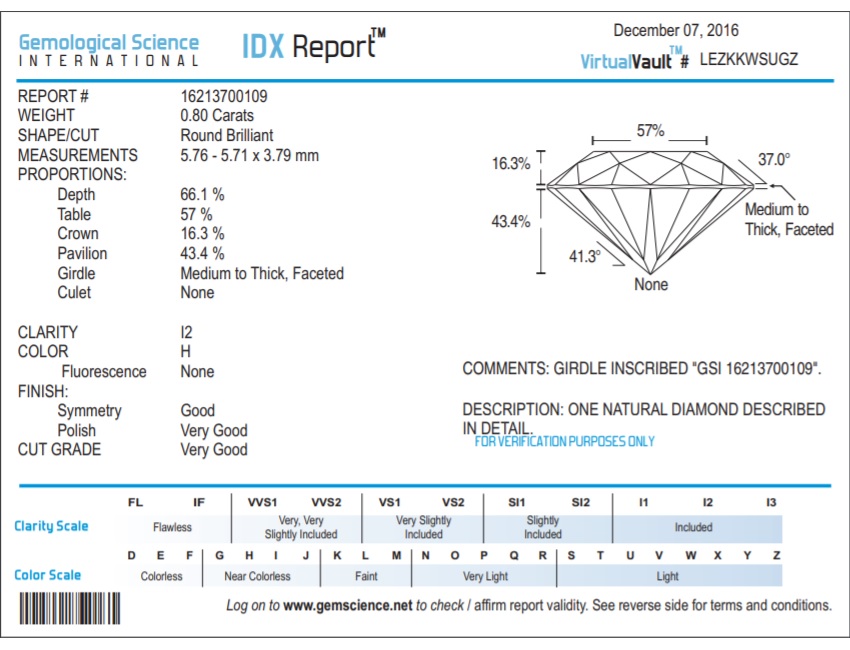
The Modified Diamond Examination report is basically a condensed version of a full-fledged grading report. Some jewelers opt for this type of grading report to market and highlight a certain aspect of the diamond. In the example below, My Diamond Story is a vendor that includes a GSI light analysis of the diamond they are selling for its better light performance.
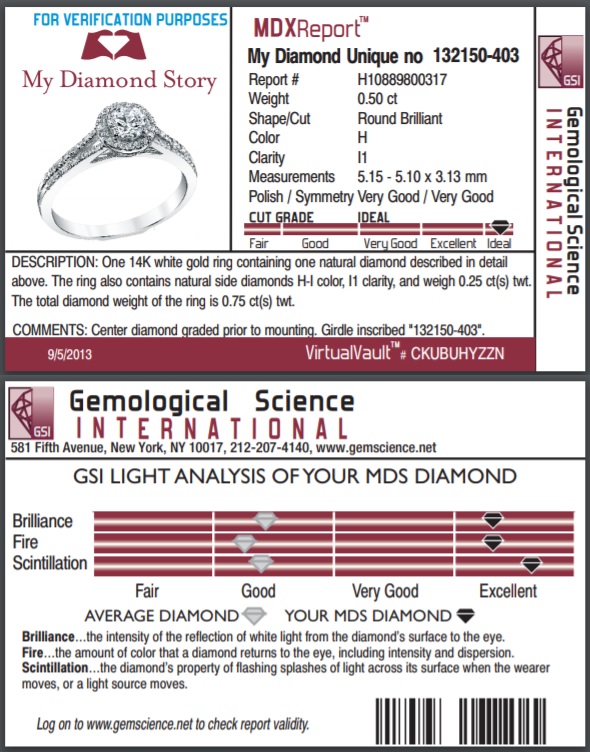
The Special Diamond Examination Report (SDX) is probably the type of document that you will come across when shopping for a diamond ring in a big-box retailer or large jewelry chain store. Here are some examples of GSI reports of authenticity to give you an idea of how they look like.
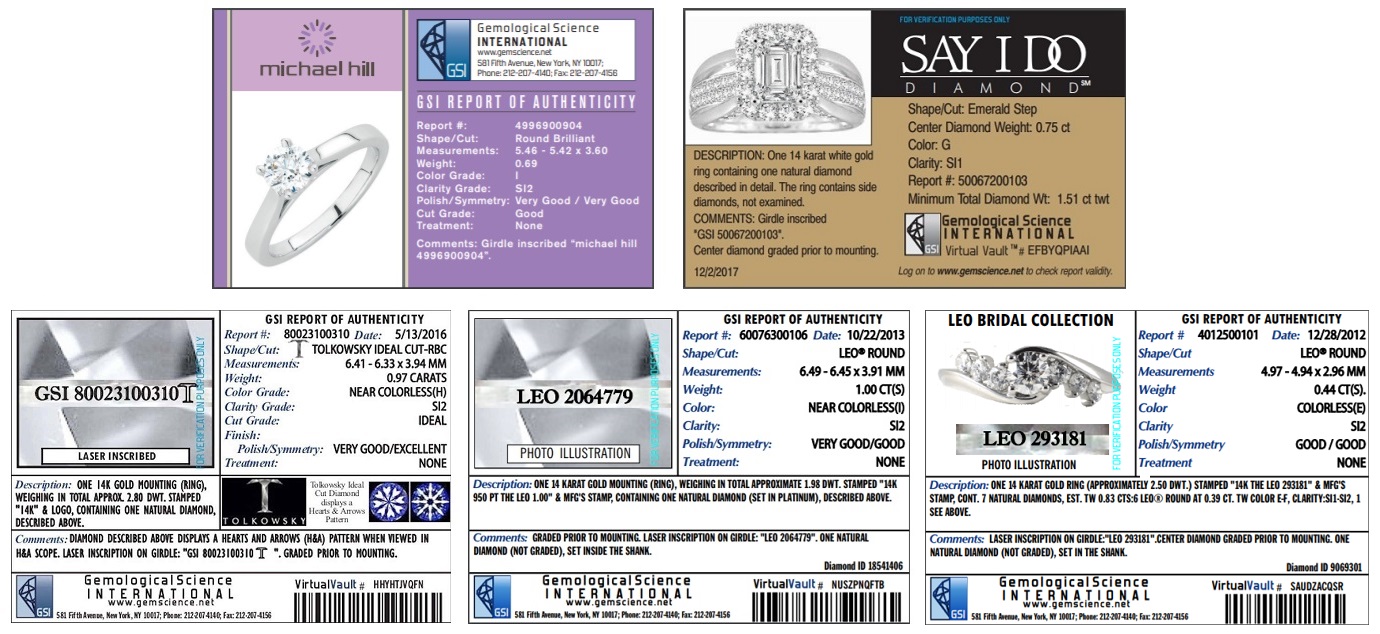
GSI offers customization to these reports with brand logos and color themes to match the corporate brands of their clients and even go as far as to include branded boxes, packaging, displays, brochures and easels.
GSI vs GIA Diamond Certificates – How Does it Impact Prices?
As you can see, GSI is a very pro-business gemological lab with its suite of customizable services. Its main clients are primarily made up of large chain stores like Zales and Shane Co where they negotiate bulk grading services at a discount. Besides cost-effective grading reports, GSI also provides relatively faster turnaround time compared to labs like GIA and AGS.
Now, if you had done some prior research or been browsing at large jewelry chain stores, you would have noticed that the prices of GIA diamond rings are often much higher than GSI diamond rings when comparing like-for-like diamond grades on paper.
So, why do these price differences exist? Does it mean you are getting a better deal with a GSI certified diamond ring?
Based on my personal experience, the difference in prices are a result of differences in the “true quality” of the diamond rings. Even though a GSI certified diamond may have a similar grade as a GIA certified diamond, the GSI diamond will be lower in price because the same diamond will likely receive a much lower grade if GIA were to assess the stone.
Vendors that utilize GSI certs know this and most of them discount their goods to market them as giving customers a better deal. Even though the discounted price may make a piece of jewelry look like a great deal, the inconsistency and looseness in grading make the purchase risky.
As a consumer, the problem with buying an engagement ring with a GSI cert is that you won’t know exactly what you are buying and this makes it extremely hard to determine a fair price to pay for it.
Can You Trust The Information Inside a GSI Grading Report or Appraisal?

Here’s the thing, most consumers may assume that as long as they are buying a certified diamond, they would be fine. Unfortunately, this isn’t always the case. In the diamond industry, the source of the grading report matters.
From my personal experience, I found that GSI’s grading is much looser than GIA/AGS. I would say that they aren’t even on the level of 2nd tier grading labs like IGI and HRD. This means that if a diamond was graded as G color and VS2 clarity by GSI, it would receive a much lower color/clarity grade if the same diamond was graded at GIA.
Now, you need to understand that different labs can have different operation practices and grading standards. That’s perfectly fine and realistically, you shouldn’t expect all labs to be grading diamonds on the level as GIA does.
In fact, GSI has never claimed that they are on par with GIA and they are just a for-profit entity that is offering a service by issuing the reports. While they may use terminology that’s similar to GIA’s, it doesn’t mean that they grade diamonds on the level of GIA’s standards.
The problem arises when salespeople and “professionals” use the GSI document as a tool to market their products as being equivalent to a GIA report.
Unethical people in the industry often use inaccurate reports to misrepresent the diamonds they are selling. This allows them to markup prices or oversell the diamond and ultimately, most shoppers end up paying more than they should for an inferior product.
Bottom Line: Is GSI Diamond Certification Good or Bad?
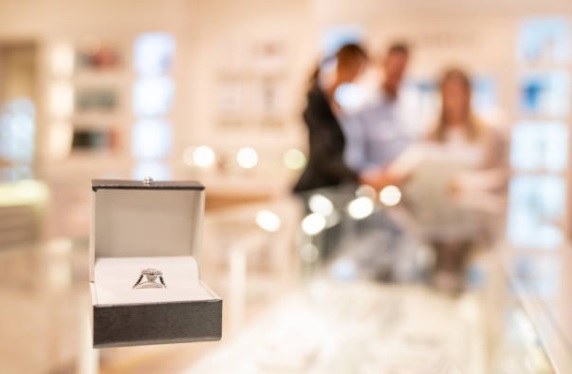
The purpose of a diamond grading report is to help you make an informed buying decision and because of this, I do not recommend buying a diamond with a GSI certificate or appraisal document. This is the same advice that I would give readers who are considering diamonds graded by lower-tier labs like EGL or IGI.
That’s because the grading standards that they use are much looser and inconsistent compared to labs like GIA or AGS.
While most jewelry pieces that come with a GSI diamond report may be seemingly cheaper, it doesn’t mean you are getting a better deal nor does it mean that the true value of the diamond has been adjusted accordingly. It’s really a stab in the dark and you won’t know what you are buying exactly.
As a professional in the industry, I can tell you that when sellers choose the type of grading report they offer for their products, they don’t do it to give the uneducated consumer a better deal. Instead, it is often done with the intention of making more profits at the expense of the unwary shopper.
If you want to buy a diamond with peace of mind and get better value for money, I recommend buying those that are either GIA or AGS certified from a reputable vendor with consumer orientated sales policies.
With that, I hope this review of GSI diamond certification has been insightful and if you have further questions or need help with anything, feel free to leave a comment below to get in touch.
Related Articles
Leave A Comment

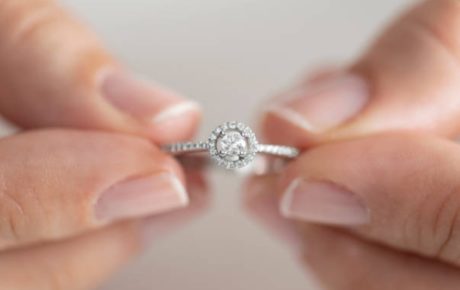


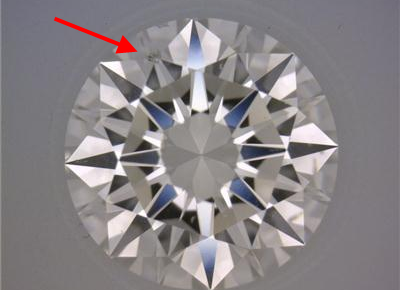









18 Comments
You seem to be making comparisons of GSI vs GIA certificates with a bias. While you claim that Gemological Science International (GSI) is not reliable, what makes GIA reliable based on your words alone with no basis to back it up?
When I read GIA’s website, they say that there is no guarantee that the grades are accurate nor do they say they are certifying anything. GIA’s process of grading a diamond is subjective because it involves humans which examine the diamond and them forming an opinion of what grades the diamonds fall into. They make a judgement call which is subjective and if a grader had a bad day, wouldn’t the grading be inaccurate? I’ve seen plenty of GIA diamonds that are downright ugly and just because a diamond has a GIA report doesn’t mean anything.
These are legal verbose that the labs use to protect themselves from liability in courts. Yes, you are right that GIA certifies nothing and that grading can be subjective. GSL does it as well and every other labs also have these legal wordings in place.
To be clear, it is technically incorrect to say something like GSI certificate because GSI only issues grading and identification reports. It’s the consumers and salespeople that call these reports GSI certificates.
Now, diamond grading is a mixture of science and art with science being that there are a set of rules/guidelines to follow where grading standards are adhered to. Sure, GIA does make mistakes during grading and when cutters who send diamonds think they made a mistake in grading, they can always have an option to resend it back for a re-grading to see the outcome.
The point is that GIA is the most consistent lab in the world and their grading standards are adhered to. The majority of other labs use GIA terminologies and claim to grade “like” GIA but fall short because if they did, they won’t be able to offer their clients something that stands out or offer a solution that helps these jewelers market their products in a better light.
Let me be absolutely clear about one thing. When jewelers or big corporations choose to send a diamond to a particular lab for grading, it is done with a calculated decision and that is often to place profits as a priority. It’s fine if you think GIA isn’t “reliable” but I am telling you they are rock solid. At the end of the day, you have a free choice on what diamond to buy or which lab to trust. I wish you and your wallet the best of luck if you go down the route of buying a diamond with an untrusted certificate.
Lastly, there is no denying that there are ugly GIA certified diamonds. I’ve seen plenty in person as well. The point here is that the ugly GIA diamonds are correctly assessed for their clarity, color properties. GIA and AGS certified diamonds are the baselines to start your search from and the endpoint depends on what you are looking for.
My boyfriend recently proposed with a ring purchased from a Zales outlet and I saw some flaws in the diamonds which I thought were dirt. When I couldn’t wash it off, I begun doing some research on the ring. As I starting reading more, it feels like he has been ripped off. The diamond ring is certified by GSL and it seems like it is not a reliable certificate because many people were warning about it. After I found your webpage, it seems to confirm my suspicion. What are your thoughts about this ring?
Carat Weight 1
Color I
Clarity I1
First of all, I think you may have a typo with GSL certification. Is it GSI or GSL? These are 2 separate entities and I think Zales work with GSI to grade their diamond jewelry products. Anyway, I would say that both will not be on the same level of reliability as compared to GIA or AGS.
The I1 clarity grade is a concern for me and the fact that you can see inclusions easily tells me that the clarity of the diamonds is bad. If your ring did come with a GSL certificate and you are concerned about the quality of the ring, you may want to consider an exchange or a return. Just make sure you discuss this with your boyfriend and let him know of your concerns.
Is GSI diamond certification good or not if I am buying a second hand ring from someone who made a purchase at Zales previously? The receipt and original documents are all intact and gsi diamond serial number checks out when I verify it on the website. I was given a deal to buy it at half the price he paid for the ring and given that it is already at half the price compared to buying a new ring, do you think it would be OK?
I went to Zales yesterday to browse for a wedding band and the salesperson told me that the GSI diamond certification is as good as GIA. Luckily I held off making a purchase and decided to do some research on gsi certification reviews which led me to your page. My diamond ring has a center stone graded by GIA when I purchased it together with my boyfriend a few months back. I tried looking for GIA certified wedding bands and was told that the stores don’t sell them because GIA don’t grade small sized diamonds found in the wedding bands. Is that true?
First of all, when comparing GSI vs GIA certification, the lab I would trust is GIA. Also, GIA does grade small sized diamonds but in the business world, most jewelers don’t send diamonds to GIA for grading if they are under 0.30 carats due to economic reasons. The cost to grade a single melee diamonds is many times the cost of the stone and for most wedding bands. It’s as simple as that. For a wedding band, I would say that a GSI diamond certification won’t be that critical as long as the size of the diamonds used in the band is kept small. If you are shopping at Zales, I do see GSI diamond appraisal documents offered for some of their wedding band selection and those are OK only if you are buying jewelry with melee diamonds or non-diamond jewelry.
I am based in Israel and was offered a deal to buy some diamonds that are certified by GIS. I was search for GIS (Gemological Institute Services) and found your page on GSI instead. Are they related? I’m guessing not but can you tell me whether G.I.S certificate is reliable or should it be avoided? I always assumed that if I buy a certified diamond, it would be good enough but how do you know if a certificate is legitimate?
https://www.labsgis.com/
I have no prior experience with GIS but I would just reiterate my stand. If any diamond isn’t graded by GIA or AGS, you can almost be sure that the quality of the diamond will be misrepresented. Whether it is GIS or GSI, my recommendation is to avoid them because it puts you in a disadvantaged position unless you know how to grade diamonds yourself. And as a trained grader, I only buy GIA/AGS diamonds. That should give you a clear idea of how professionals approach gem buying. We don’t dabble in dubious grading reports and if the pros who have knowledge about what they are doing aren’t buying diamonds in this manner, why should a layperson do so?
I’ve been on Shane Co.’s website and found a few diamond rings with GSI diamond certificates. When I asked about the differences between GIA and GIS, the salesperson told me that they were diamond certificates that prove the quality of the diamond. In fact, the GIS certified engagement rings were better deals as they were much cheaper and on their website link: https://www.shaneco.com/jewelry-education/diamond-certificates,
They claim that “The GSI’s grading standards and consistency are similar to those of the IGI and the GIA.” It seems to contradict what you are saying here and yet something bothers me because of the differences in value of the rings.
I think you just answered your own question. Well, if the GSI grading reports are actually on par and as strict as GIA’s, why would there be a discrepancy in prices. Is it out of goodwill that GSI diamond rings are priced cheaper? If they are the same, you should be asking them to price match a GIA certified diamond ring to that of a “similar’ GSI certified diamond ring. Why aren’t jewelers like Shane Co doing so? That’s because they “discount” the GSI diamonds because the true quality of the diamonds will be lower in quality if GIA were to grade them. When comparing GIS vs GIA, there’s really no comparison and as a shopper who wants to protect your own interest, you should only buy GIA graded diamonds.
If GSI is an independent grading lab, won’t they be impartial? You claim that GSI is not being consistent with their grading report but AGS also offers branded reports like that found at Brian Gavin. Seems like you have double standards.
The definition of an independent grading lab is that it doesn’t sell diamonds and have no vested interest in the grade they assign to a diamond. Being independent is a good thing but that is only one aspect of whether a lab is reliable or not. The other aspect is the grading standards that they use. That’s the part that many gem labs fall short in comparison to GIA or AGS.
I’m not sure why I am getting so much hate for educating consumers. First of all, I am not being biased and I’m just stating facts. You are correct that AGS also offers branded reports that can incorporate certain elements like the logo or a computer scanned hearts and arrows diamonds. What I am pointing out with GSI is that they use different grading methodologies to derive the clarity/color of the item they are grading.
AGS is consistent in that aspect when it comes to a certain type of diamond report. To be clear, AGS does use different methodologies for different categories of grading reports like using ray tracing analysis for certain reports. But they don’t use different grading methods within the SAME TYPE of report.
Also, they only grade diamonds in the loose form. GSI doesn’t. This is a critical aspect and I think it muddies up the quality of the grading report GSI offers.
I think the “hate” you are getting is due to your extremely harsh criticism of GSI with no evidence to back it up. Sure they don’t have the same standards as GIA, but the consumers they are serving aren’t usually anywhere near the price point of GIA graded diamond consumers. It seems to me that GSI is perfectly fine for comparing one diamond at Zales to another diamond at Zales. Or comparing a diamond at Zales with one at Kay, or Jareds. I undrstand the point you are trying to make, I just think you are overstating it without any real evidence of wrong doing or innaccuracy by GSI. Put your $ where your mouth is and buy a GSI graded diamond, send it to GIA and compare the differences in the reports for us. That would give your opinion much more credibility.
That’s a very good suggestion. Thanks for the feedback!
I am looking at an engagement solitare diamond ring at Zales. It is from their celebration collection. Zales said I was on clearance and it is certified. When I asked for the certification number, it started with the letters CEL following numbers. Am I safe with buying this ring? I was told by another store That meant Zales did their own certification for their celebration diamond collection.
Safe in what sense? Safe in the sense that you are getting a real diamond but getting one that will be significantly different in quality because of misrepresentation by an unreliable grading report? My advice is don’t buy a diamond ring without a GIA or AGS certificate. You are setting yourself up for disappointment.
My ring has a GSI and the report certificate. BUT it is not showing on GSI website so how do you know then?
GSI offers a variety of grading documents and you may not be looking at the right place for the verification. Check with the seller you bought the ring from and get them to show you how to authenticate the document.